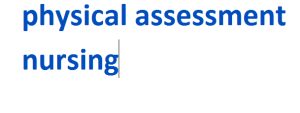physical assessment nursing 2024-2025
physical assessment nursing 2024-2025

Physical assessment is a critical part of nursing practice. It involves the systematic collection of data about a patient’s physical status, including their vital signs, body systems, and overall health. In this article, we will provide comprehensive information on physical assessment in nursing, including its importance, components, and techniques.
Importance of Physical Assessment in Nursing
- Physical assessment is essential in nursing for several reasons. First, it provides a baseline of information that can be used to monitor changes in a patient’s condition over time. Second, it helps nurses identify potential health problems and develop appropriate interventions. Finally, physical assessment is an opportunity for nurses to establish rapport and build trust with their patients, which can improve patient satisfaction and outcomes.
Components of Physical Assessment
- Vital Signs – Vital signs include measurements of a patient’s body temperature, blood pressure, heart rate, and respiratory rate. These are essential indicators of a patient’s overall health status.
- General Appearance – This includes a patient’s level of consciousness, skin color, and overall appearance.
- Head and Neck – This component includes an assessment of the patient’s head, face, eyes, ears, nose, mouth, and neck.
- Chest and Lungs – This component involves an assessment of a patient’s respiratory status, including their breath sounds, chest movement, and oxygen saturation.
- Cardiovascular System – This component involves an assessment of a patient’s heart, including their heart sounds, pulse, and blood pressure.
- Abdomen – This component involves an assessment of a patient’s abdominal region, including their bowel sounds and any tenderness or discomfort.
- Extremities – This component includes an assessment of a patient’s arms and legs, including their strength, range of motion, and any swelling or pain.
Techniques of Physical Assessment
- Inspection – This involves the visual examination of a patient’s body, looking for any abnormalities or changes.
- Palpation – This involves the use of touch to assess a patient’s body, including feeling for any lumps, bumps, or tenderness.
- Percussion – This involves tapping on a patient’s body to assess the density of underlying tissues.
- Auscultation – This involves listening to a patient’s body sounds, such as their heart and breath sounds.
Conclusion
- Physical assessment is a critical component of nursing practice. It involves the systematic collection of data about a patient’s physical status, including their vital signs, body systems, and overall health. Physical assessment is essential for identifying potential health problems and developing appropriate interventions. It also provides an opportunity for nurses to establish rapport and build trust with their patients. With a comprehensive understanding of the components and techniques of physical assessment, nurses can provide the best possible care to their patients.
Click here for South African Nursing Colleges and Schools Application 2023-2024
RELATED LINKS